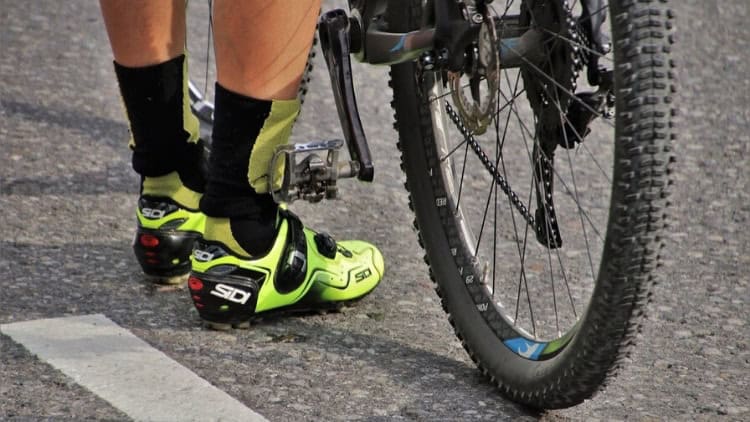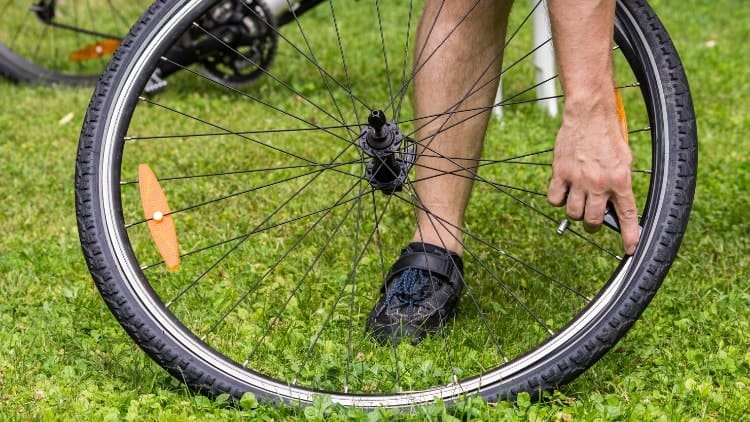Regardless of how long you’ve been biking, just about every rider has experienced that moment when they needed to check their tire pressure without a gauge.
Whether you’re miles deep into a Mountain Bike trail or hours deep in a group ride, it can be frustrating thinking you need to adjust your tire pressure.
This can be even more frustrating when you find out that you don’t have a tire gauge on you.
So what can you do? Do you continue riding or try to figure out how to get the right PSI?
In this article, we will give you some tips on how to check your tire pressure without a gauge, along with some tips to help you get it corrected.
If you don’t have a tire pressure gauge, you can check your bike tire pressure by; testing the feel, doing the pinch check, having someone visually check the sag, and even trying the puddle trick. This will help you get a rough estimate of how much pressure you have or need. Just remember that this is temporary.
To help you get it figured out, we will go over just how you can check bike tire pressure without a gauge, along with some tips to get the best estimate.

Methods for Checking Your Bike Tire Pressure Without Gauge
As a preface, it is important to note that none of these methods will give you an exact reading.
For this reason, newer riders should try their best to find a tire gauge.
For more seasoned riders, you are more familiar with your bike and how your tires should feel.
Although you cannot get an exact measurement, you should be able to get very close to the correct PSI.
1. Test By Feel
As you become an avid rider, you slowly start to become more and more familiar with your bike and how it rides.
This is a good thing when it comes to air pressure, as you can usually tell when your tires need air.
On the flip side, a seasoned rider can also tell when they have too much air in their tires.
An under-inflated tire will feel sluggish and hard to maneuver. You may even bottom out a few times riding over obstacles.
An over-inflated tire will feel too responsive, causing more dramatic movements and bouncing around more. You also will feel a significant loss in traction, making you feel less stable on the bike.
Even if you have a good feel for your bike, you will end up adjusting your tire pressure a few times before finding a good setting.
2. Pinch Test
If you ever rode bikes growing up, you are probably familiar with this next one.
The thumb check, or pinch check is one of the oldest ways to check the air pressure in a bike tire without a gauge.
This check involves pinching the tire sidewalls, just above the rim, to feel for tightness.
Again, there is no way to tell exactly how much air you have in your tire, so you may end up adjusting the tire pressure a few times.
3. Check the Sag
If you happen to be around another rider, you may be in luck.
It is hard to check the tire pressure in your bike because as soon as you sit down, the tires flatten further down.
This is where that other rider comes in handy, as they are able to see how much the tires flatten while you’re riding.
Once they see how flat the tires look once your weights on the bike, they can help you add the right amount of tire pressure.
4. Puddle Trick
This next one is a bit “iffy” and I have never tried it myself, however, some riders say you can check your tire pressure by riding through a puddle.
Supposedly, the height that the water comes up to on the tire sidewalls will tell you if you need air.
Naturally, this involves riding pretty slow and you have to find a really short puddle.
If you have luck, please reach out to info@hobbybiker.com so I can stop being so hard on this method.

How do I know if my Bike Tire has Enough air?
For some of us, especially those avid riders, it is usually pretty easy to tell when your bike tires are low on air.
The real problem comes when you need to know when your tire has enough air.
In fact, most riders tend to over-inflate their bike tires – even when they have a tire pressure gauge.
So how do you know when you have enough air in your Bike tires?
If you don’t have a tire pressure gauge, you can check if you have enough air in your bike tires by; giving your bike a test ride, visually checking the sag, or pinching the tire for feel.
- Test Ride
If you don’t have a tire gauge, one of the best ways to see if you have enough air in your bike tire is to give your bike a test ride.
Of course, this is not an exact science, however, you will be surprised just how familiar you become with your bike.
With enough air pressure in your tire, your bike should feel tacky but responsive. If you feel less stable than normal or have a loss of traction, you probably have too much air in your tires.
- Check Sag
If you have a friend or a great deal of patience, you can visually check the sag in your tires to see if you have too much air.
This works best if you’re a frequent rider, as you will have a good idea of what a tire should look like when you’re sitting down.
You may have to make a few adjustments, but this should get you in the right direction.
- Pinch Check
As I mentioned earlier in this article, the pinch method for checking a bike tire has been around for generations.
To see if your bike tire has too much air in it, pinch it on the sidewalls, just above the rim.
You should be able to pinch it inward a few centimeters before the resistance gets too strong.
If it is too hard to pinch straight away, you have way too much air in your bike tires.

What Happens if you put too much air in your bike tires?
No matter how experienced of a rider you are, we all put too much air in our bike tires at one point or another.
While this is easily corrected and usually has no cause for alarm, it is still important to know what happens when you have too much air in your bike tires.
Here are the four main things that happen when you have too much air in your bike tires:
- Less Rolling Resistance
One of the first things that happens when you have too much air in your bike tires is that you have less rolling resistance.
This can actually be considered a good thing depending on the circumstance, but when your tire is over-inflated, this is bad.
Lower rolling resistance will make you faster and can help you more easily maintain speed.
But this only applies when you’re riding over flat and smooth surfaces.
Once you hit the slightest bump, more energy is wasted bouncing or pushing you in another direction, making you slower overall.
- Significant Loss of Traction
When your bike tire is over-inflated, you will notice a significant loss in traction.
Your bike tires are meant to deform a little to maintain optimal grip on the ground or surface.
When they have too much air, they lose that ability to deform, making them less stable overall.
This is especially risky when you’re turning, as this is when you will have the least amount of tire in contact with the ground.
- Extra Bounce and Rebound
When your bike tires have too much air, they become tight and really stiff.
This can feel great at first when you notice how much more responsive your bike is.
But is also a real negative, as your bike becomes less stable overall.
In addition to the loss of traction, smaller bumps will feel more dramatic and it will be a lot easier to get bounced off the bike.
- Increased Chance to Damage or Pop
Finally, you run the risk of popping or damaging your tires or tunes when you have too much air in them.
As I mentioned before, your bike tires are meant to deform a certain amount when you turn or go over bumps.
This not only helps maintain traction, it also allows your bike tires to offload all that air pressure when you’re putting a lot of weight on your bike.
When you have too much air pressure in your bike tires, your tires no longer deform when you hit a bump or shift your weight.
This results in a constant force of high air pressure pushing against your tires and tubes, making them more prone to pop or tear.
Conclusion
In conclusion, there is no way to guarantee that you have too much air pressure in your bike tires without a gauge.
However, with a little patience and a good familiarity with your bike, you can recognize the telltale signs.
Use this article as a guide to help you familiarize yourself with your bike, as well as a resource to help you check if you have too much air in your tires.
Good luck and safe riding!

